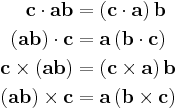Dyadics
Dyadics are mathematical objects, representing linear functions of vectors. Dyadic notation was first established by Gibbs in 1884.
Contents |
Definition
Dyad A is formed by two vectors a and b (complex in general). Here, upper-case bold variables denote dyads (as well as general dyadics) whereas lower-case bold variables denote vectors.
In matrix notation :
In general algebraic form:
where  and
and  are unit vectors (also known as coordinate axes) and i,j goes from 1 to the space dimension.
are unit vectors (also known as coordinate axes) and i,j goes from 1 to the space dimension.
A dyadic polynomial A, otherwise known as a dyadic, is formed from multiple vectors 
A dyadic which cannot be reduced to a sum of less than 3 dyads is said to be complete. In this case, the forming vectors are non-coplanar, see Chen (1983).
The following table classifies dyadics:
| Determinant | Adjoint | Matrix and its rank | |
| Zero | = 0 | = 0 | = 0; rank 0: all zeroes |
| Linear | = 0 | = 0 | ≠ 0; rank 1: at least one non-zero element and all 2x2 subdeterminants zero (single dyadic) |
| Planar | = 0 | ≠ 0 (single dyadic) | ≠ 0; rank 2: at least one non-zero 2x2 subdeterminant |
| Complete | ≠ 0 | ≠ 0 | ≠ 0; rank 3: non-zero determinant |
Dyadics algebra
Dyadic with vector
There are 4 operations for a vector with a dyadic
Dyadic with dyadic
There are 5 operations for a dyadic to another dyadic:
Simple-dot product
For 2 general dyadics A and B:
Double-dot product
There are two ways to define the double dot product. Many sources use a definition of the double dot product rooted in the matrix double-dot product,
whereas other sources use a definition unique (usually referred to as the "colon product") to dyads:
One must be careful when deciding which convention to use. As there are no analogous matrix operations for the remaining dyadic products, no ambiguities in their definitions appear.
The double-dot product is commutative.
There is a special double dot product with a transpose
Another identity is:
Dot–cross product
Cross–dot product
Double-cross product
We can see that, for any dyad formed from two vectors a and b, its double cross product is zero.
However, for 2 general dyadics, their double-cross product is defined as:
For a dyadic double-cross product on itself, the result will generally be non-zero. For example, a dyadic A composed of six different vectors
has a non-zero self-double-cross product of
Unit dyadic
For any vector a, there exist a unit dyadic I, such that
For any base of 3 vectors a, b and c, with reciprocal base  ,
,  and
and  , the unit dyadic is defined by
, the unit dyadic is defined by
In Cartesian coordinates,
For an orthonormal base  ,
,
The corresponding matrix is
Rotation dyadic
For any vector a,
is a 90 degree right hand rotation dyadic around a.




















![\mathbf{A}
\!\!\!\begin{array}{c}
_\times \\
^\times
\end{array}\!\!\!
\mathbf{A} = 2 \left[\left(\mathbf{a}_1\times \mathbf{a}_2\right)\left(\mathbf{b}_1\times \mathbf{b}_2\right)%2B\left(\mathbf{a}_2\times \mathbf{a}_3\right)\left(\mathbf{b}_2\times \mathbf{b}_3\right)%2B\left(\mathbf{a}_3\times \mathbf{a}_1\right)\left(\mathbf{b}_3\times \mathbf{b}_1\right)\right]](/2012-wikipedia_en_all_nopic_01_2012/I/3d64f89e390e61852325f734cf13cd02.png)









